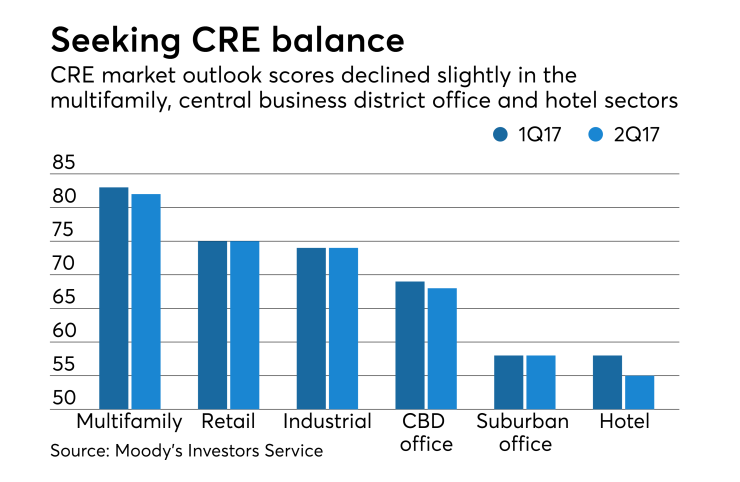The supply-demand outlook in commercial real estate markets took a slight dip nationwide for the first time since early 2016 and financing for some CRE property types is getting more difficult to arrange.
"For a property type like multifamily there is plenty of financing, but I think if you have a product type such as office and retail it becomes more challenging," said Mitch Paskover, president of Continental Partners, a company that provides advisory services for real estate capitalizations.
The overall near-term outlook for new construction and space absorption across all commercial property types dipped slightly in the Moody's Investors Service Red-Yellow-Green report. The CRE benchmarking tool uses a 100-point scale and color coding to assess growth in supply relative to demand and vacancy rates for CRE property types both nationally and within individual markets.
These real estate market supply and demand variables "determine the outlook for the commercial properties that support the majority of the collateral backing commercial mortgage-backed securities," Moody's said.
The overall market reading of 69 for the second quarter of 2017 was down one point from the previous quarter and the first decline since the first quarter of 2016. But that score is still good enough for the overall market to remain in the healthy "green" category, Moody's said, reflecting the fact that scores also remain in the green category for many underlying property types. Still, small pockets of the market did decline.

Multifamily, the leading property type in the CRE market, is seeing a little weakness in its supply-demand outlook.
"The multifamily sector remained the highest scoring sector in the second quarter of 2017, though its composite score dropped a point, to Green 82," said Paul Cognetti, a Moody's analyst, in a press release. "Forecast demand declined and the vacancy rate improved."
The outlook for multifamily demand fell to 1.6% from 1.9% between the first and second quarters, and the pace of construction remains above 2.5% in 17 markets, according to Moody's.
Central Business District office properties, which had a lower green score of 68, also saw a one-point decline between the first and second quarters. CBD scores decreased in 29 markets and only increased in 11.
Credit-risk-averse construction financing practices be may the reason the supply-demand outlook is relatively stable in some weaker sectors of the market like office and retail but getting a little out of whack in a strong sector like retail.
"Construction financing is very difficult right now unless it's multifamily," Paskover said. Multifamily construction as a percentage of existing inventory remained the same between the first and second quarters, according to Moody's.
Construction supply is more or less in line with demand in the retail sector even as it continues to be transformed in some subsectors by online sales, Moody's found.
The retail score remained unchanged at 75 in the second quarter, which keeps it in the green range.
Suburban office properties' yellow score of 58 also remained unchanged in the second quarter.
Among the pressures on the property type is a high vacancy rate in the Houston market, which increased to 21.7% from 20.5% in the second quarter and drove the city's red score down eight notches to 21. There is no forecast demand for the Houston market and construction there is expected to increase by 1.1%.
The hotel market also is under some pressure. Its yellow composite score dropped three points to 55 due to an increase in the supply demand imbalance.
In contrast, industrial maintained an unchanged green score of 74 as it vacancy rate fell to 7.8% from 8% the previous quarter and 8.2% a year ago.





